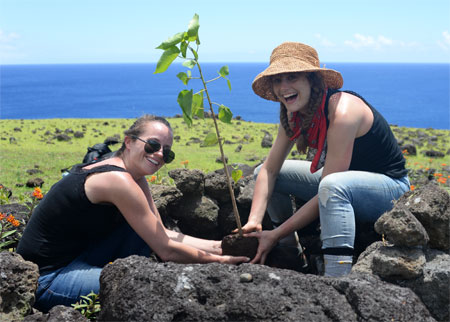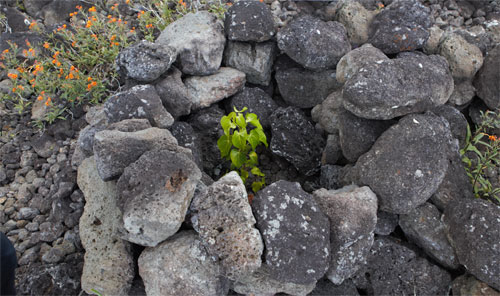
Plant a tree at Easter Island
Easter Island was once a jungle of palm trees. As a more advanced knowledge and understanding of mechanics was reached for every century, building and transporting increasingly big moai statues was possible. This required an excessive amount of lumber, and in the end, all of Easter Island was deforested in approximately 1650 AD.
As there hasn't been much trees and plants left to hold the soil in place the latest centuries, Easter Island has been a victim to erosion ever since, as the soil gets flushed into the sea. To help with this situation, and with hopes to inspire more local agencies to do the same, we plant a tree every time we travel on horseback along the north coast.
Slowly, we are reforesting Easter Island, one tree at a time.
Today, Easter Island nature has changed and it's harder for plants to grow. The lack of trees causes a more windy climate, as there are no trees left to block the winds. Trees and plants from ancient times had the feature of binding certain minerals to the ground, which Easter Island now is lacking. Horses and cows today roam freely across the island, and eat any sprouts that pop up. Our trees are planted in the most remote areas of the island, where we are unable to keep weeding and watering them.
Ancient Easter Island plantation techniques
Because of the challenges sprouting trees and plants face at Easter Island, our trees are planted with lots of care. To ensure their survival and well-being, we combine two ancient plantation techniques called manavai and kīkiri that are common throughout Easter Island.
Manavai rock wall
The manavai is a circular rock wall within which you plant. The rock wall protects the plants from the winds ripping apart their leaves. In addition to this, the soil will be more humid, as no wind will dry it out.
Kīkiri rock garden
This is simply a layer of rocks, and trees are planted inbetween the rocks. This might seem basic at first, but truly is ingenious. The rocks blocks out the winds from the ground underneath, which keeps the soil from drying up, and the rocks further keeps the area humid. Rocks with holes, so called vesicular basalt, or mā'ea pū-pū in Rapa Nui, are best suited for this, since the holes retain water.
The rocks in the kīkiri rock garden constantly fertalize the ground, as the rain brings minerals from the rocks into the ground. To fertalize soil with rocks is called lithic mulching.
Tours in which we plant trees
We are currently planting trees in two tours - our north coast hike with horseback addition, or our three day adventure tour on horseback Ancestral Adventure. Go to our tours page to book any of these tours.


